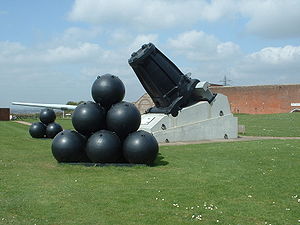- Mallet's Mortar
-
Mallet's Mortar
Mallet's Mortar at Fort NelsonType Siege mortar Place of origin UK Service history Wars Unused Production history Designer Robert Mallet Manufacturer C. J. Mare ironworks, Blackwall (bankrupted), Completed by Horsfall & Co., of Liverpool and Fawcett, Preston & Co. Produced March 1857 Number built 2 Specifications Weight 42 long tons (43 t) (42,674 Kg) Length 11 feet (3.353 metres) Cartridge weight 1.25 long tons (1.27 t) (1270 Kg) Calibre 36 inch (914 mm) Effective range 1½ miles with 2,400 lb shell Mallet's Mortar was a British siege mortar built for, but never used in, the Crimean War
The mortar was design by Robert Mallet. It was constructed in sections so that it could be transported.
Robert Mallet first made his design public in 1854.[1] There was little response from the authorities until Mallet wrote to the then Prime Minister Lord Palmerston in March 1855.[1] Palmerston was taken with the idea and instructed Board of Ordnance to arrange for the construction of two mortars of Mallet's design.[1]
Thames Ironworks and Shipbuilding Company won the contract at a price of £4,300 per mortar.[1] The company's bankruptcy resulted in the work being divided among three firms which managed to deliver the mortars in May 1857.[2]
Testing began on 19 October 1857 with further testing on 18 December 1857, 21 July 1858 and 28 of July 1858.[3] Each test was brought to an end by damage to the mortar.[3] A total of 19 rounds were fired with a rate of about 4 shells an hour being achieved.[3]
Shell weight was between 2,352 and 2,940 pounds (1,067 and 1,334 kg).[3] In testing with an 80 pound charge it fired the lighter shell a distance of 2,759 yards (2,523 m) with a flight time of 23 seconds.[3]
Both mortars are in the collections of the Royal Armouries, the UK's national museum of arms and armour.
The gun used for testing has been preserved at Repository Road opposite the Royal Artillery army base in Woolwich while the unfired gun is on display at the Royal Armouries Fort Nelson near Portsmouth.[4]
See also
- List of heavy mortars
- List of the largest cannon by caliber
Notes and references
- ^ a b c d Moore, David; Salter, Geoffrey (1995). Mallet's great mortars (Great Victorian guns-1). Palmerston Forts Society. pp. 1–2. ISBN 0952363437.
- ^ Moore, David; Salter, Geoffrey (1995). Mallet's great mortars (Great Victorian guns-1). Palmerston Forts Society. p. 3. ISBN 0952363437.
- ^ a b c d e Moore, David; Salter, Geoffrey (1995). Mallet's great mortars (Great Victorian guns-1). Palmerston Forts Society. pp. 5–6. ISBN 0952363437.
- ^ Moore, David; Salter, Geoffrey (1995). Mallet's great mortars (Great Victorian guns-1). Palmerston Forts Society. pp. 8–9. ISBN 0952363437.
External links
Categories:- Mortars of the United Kingdom
- 914 mm artillery
Wikimedia Foundation. 2010.

